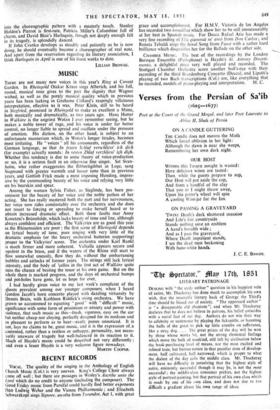BALLET
Sadler's Wells Theatre Ballet. (Sadler's Wells.) JOHN CRANKO, the active young resident choreographer of the Sadler's Wells Theatre Ballet, has just presented another new work, Harlequin in April. Rather curiously the programme calls it a " pantomime with divertissements," which seems far too modest a description for a ballet so well knit together and absolutely without any padding. But this is not the only misleading feature of Harlequin in April. Mr. Cranko quotes lines from The Burial of the Dead in T. S. Eliot's Waste Land—incidentally, this programme quotation does not indicate that fourteen lines have been cut art of the middle—which invites us to decide how well he has interpreted so profound a motif. This is his great mistake. His ballet is on a different level, for he restricts man's aspiration to one particular aspect, whereas Mr. Eliot's lines surely suggest a far wider and deeper meaning. In his first act the choreographer has interpreted the poet's " stirring Dull roots with spring rain " at)i has finely suggested the human being, in the shape of Harlequia as breaking away from earth-bound life to search for his ideal. But then comes the anti-climax in the discovery that the ideal is only the sensual love of man for woman, a goal which is neve reached because of the barrier set up by the Unicorn, " the tradi- tional guardian of chastity." I do not believe in too literary al approach in the evaluation of the interpretative arts, but in tlut instance Mr. Cranko has insisted upon it, and thereftire one cal only conclude that he has chosen symbols too light in weight and too narrow in scope for so deep a theme. Why not omit Mr. Eliot's lines from the programme and enable . i the ballet to stand upon its own feet ? It is quite capable of aloing l so, for on its own plane it is beautifully realised ; the music bt Richard Arnell, the decor and costumes by John Piper, are Aovel
into the choreographic pattern with a masterly touch. Stanley Holden's Pierrot is first-rate, Patricia Miller's Columbine full of charm, and David Blair's Harlequin, though not deeply enough felt in its tragedy, is splendidly danced.
If John Cranko develops as steadily and patiently as he is now doing, he should eventually become a choreographer of real note. And apart from the reservation regarding its literary association, I think Harlequin in April is one of his finest works to date.
LILLIAN BROWSE.







































 Previous page
Previous page